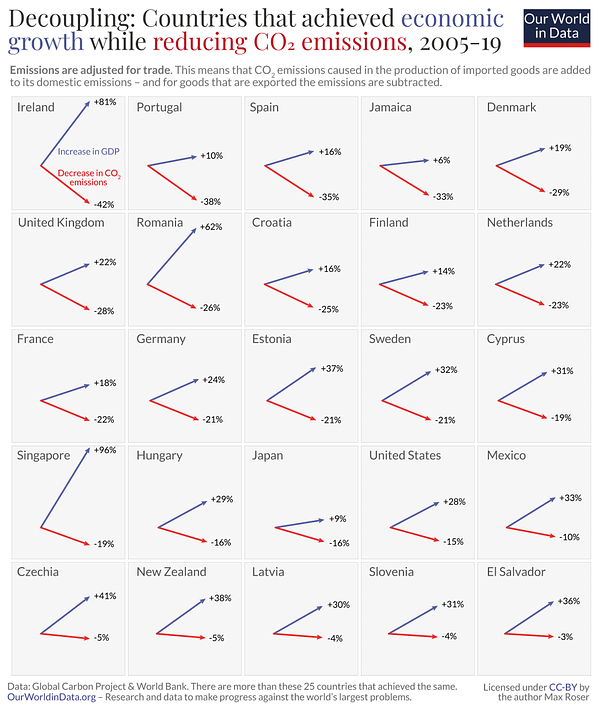Welcome to the mid-week update from New World Same Humans, a newsletter on trends, technology, and society by David Mattin.
If you’re reading this and haven’t yet subscribed, join 22,000+ curious souls on a journey to build a better future 🚀🔮
To Begin
I join you at a historic moment for my country, the United Kingdom, because we received the sad news that the Queen died yesterday at age 96 after 70 years on the throne. What an incredible life.
So the second Elizabethan age is over for us here in the UK, and we now welcome King Charles III. History is turning as history does.
And it’s turning in all kinds of other ways, too. What have we got in store?
This week, a new AI technique sees a team of virtual humanoids learn to play football.
Meanwhile, we look at the evidence on a fundamental question for the coming decades: can we decouple economic growth and carbon? And the US wants to prevent its top tech firms from sharing their secrets with China.
Let’s get into it.
🌐 Simulated living
This week, new work from Alphabet’s DeepMind division offers a glimpse of our simulated future.
In a new research paper and blog post, the DeepMind team describe how they used an AI to train virtual humanoids to play football.
They threw a team of digital stick figures into a virtual environment that simulates real physics: Earth-like gravity, inertia, and all the rest. They then used a special technique called neural probabilistic motor primitives (NPMP) to turn the humanoids from flailing no-hopers into a skilled team.
In a two-stage process, the AI was first trained on motion-capture video clips of humans playing football. This taught it basic control over the humanoids, enabling them to run and kick a ball. Next, the AI simulated 20 years worth of football matches in around two weeks, using a trial and error method to learn advanced skills such as dribbling, shooting on goal, and, finally, team coordination.
The result? A team of virtual stick figures that look and perform eerily like a Premier League football club.
Still, at first glance this might all seem pretty niche. Why does it matter?
⚡ NWSH Take: I’ve written a lot on Alphabet’s Everyday Robots division, and its mission to create household helper robots that can load the dishwasher and make a cup of tea. A core challenge here? We need embodied AIs that can navigate the demands posed by complex physical environments. In other words, we need AIs that can cope with having a body. The real power of the NPMP skill model, say the DeepMind team, will come when we lift it out of simulated environments and use it to train robots to move through our factories, hospitals, and kitchens. // Meanwhile, this work is also a reminder of the rising power of a new generation of AI-fuelled simulations. The best AI chess players have changed the game by playing moves no human would ever have seen. If we give DeepMind’s virtual football team long enough, will it devise football strategies that are entirely new? In the coming decades, our ability to create sophisticated simulations will transform our understanding of multiple domains of human endeavour, from sport to science. See, for example, NVDIA’s massive Earth-2 simulation of the planet. But the even greater prize in sight: can we build meaningful simulations of entire human societies? Social scientists such as Peter Turchin, who marries history and mathematics via a new discipline he calls cliodynamics, are working on such simulations, and believe they’ll soon generate powerful new insight into collective human behaviour and the hidden patterns that shape our shared past and future. NWSH will keep watching.
💥 A tale of growth and carbon
Can we decouple economic growth and the burning of fossil fuels? This week, charts published by the brilliant Our World in Data offered an emphatic answer.
Co-founder Max Roser highlighted a story shared by 25 countries: carbon emissions down, growth up.


Others were quick to point out that in the case of many of those 25 countries, the picture is more complex than these simple charts allow. Ireland, for example, saw an 81% increase in GDP and a 42% decrease in carbon emissions between 2005 and 2019. But much of that reduction in carbon emissions came during and immediately after the 2009 financial crisis, when GDP also fell — a blow to the idea that growth and carbon can be decoupled.
The argument raged on Twitter (as arguments do). But this is far more than a technical debate about some charts. It strikes at the heart of a fundamental question for the 21st-century: is green growth possible?
Roser believes that we must do everything we can to ensure the answer is ‘yes’. In this long post on global poverty reduction and growth he says:
“If those who say that it is not possible to decouple growth from environmental harm are right, then the future… will be either one of continuing global poverty or one of continuing environmental destruction, or both. Much of our work here at Our World in Data is therefore dedicated to studying how it might be possible to achieve a future in which an increasing share of humanity is less poor and in which humanity has a smaller negative environmental impact.”
⚡ NWSH Take: This newsletter has always been animated by a set of core themes. One of them? The search for a new framework to structure, and make sense of, our politics in the 2020s. As I argued way back in NWSH #6, the global heating emergency has rendered the traditional conservative vs progressive framework obsolete; we need something new. // Perhaps that something new is the decouple vs degrow dichotomy that underpins the debate that I outline above, which unfolded in response to Roser’s charts. That dichotomy asks: should we decouple economic growth from carbon and then continue to pursue it? Or must we accept that this is impossible, and instead shrink our economies in order to protect the planet? Roser believes that to embrace degrowth means to condemn billions in the Global South to continued poverty. Proponents of degrowth say that needn’t be so; the rich world can degrow, they say, while empowering poorer nations to keep getting richer. // The answer you give to this questions — decouple or degrow? — necessarily shapes much of your thinking on our collective path ahead. In that way, it’s a far more useful ordering framework than conservative vs progressive. Right now only one side, decouple, is represented in mainstream politics. But we may yet come to see mainstream degrowth parties spring up across the Global North.
👨💻 Had your chips
This week, a further glimpse of the geopolitical tech wars that lie ahead.
The US announced that it will ban tech companies from building ‘advanced technology facilities’ in China for at least a decade.
The ban will apply to US technology firms that receive government funding. It comes in the wake of the US Chips and Science Act, which will see $53 billion spent to upscale domestic production of semiconductor chips, which all kinds of computers rely on. The bill is intended to reduce US reliance on chips manufactured in Asia; Taiwan and South Korea are currently the world’s top producers.
The US is amid a broader recalibration of its relationship with China when it comes to technology. Last week, US chip giant NVIDIA said it had been told to stop exporting two kinds of AI chips to China; the US Department of Commerce say the ban is meant to ‘keep advanced technologies out of the wrong hands…and protect U.S. national security and foreign policy interests’.
⚡ NWSH Take: Back in New Week #95 I wrote on US tech company Oracle and its audit of TikTok’s algorithms and content moderation practises, which is intended to ensure they aren’t being manipulated by the Chinese authorities. Now, we have these moves to limit the physical presence of US tech companies in China, and to ensure that high-powered AI chips aren’t being sent there. // Put it all together and a picture emerges of a definitive shift in stance. It’s not before time. For decades, the Global North has leaked technological hardware, research, and expertise to China. Check out this British intelligence services assessment that China’s strategy to grab western tech and expertise has been decades long ‘coordinated campaign on a grand scale’. At home, China is using technologies of western origin —including facial recognition — to build an unprecedented techno-authoritarian state. Meanwhile, it’s possible that the CCP are sucking a constant supply of user data out of the world’s most popular social media app. // In the 21st-century, technology and data are at the bleeding edge of the geopolitical struggle for power and influence. If the Global North is now waking up to that, then great. But it may be too late: the evidence suggests China is fast catching up with the US when it comes to AI research, and may soon overtake.
🗓️ Also this week
🪐 MIT researchers say they’ve created a lunchbox-sized cube that can create oxygen on Mars. The small box, called MOXIE, landed on Mars last year with the Perseverance rover. Since then, said MIT scientists this week, several tests have seen it successfully suck in Martian air and output oxygen at rate of six grams per hour — that’s about the same oxygen production rate as that managed by a single tree.
🧠 Meta have created an AI that can reproduce the words a person is hearing by reading their brainwaves. Meta researchers say the technology could one day allow those who can’t talk or type to communicate more fully with others.
🌅 Authorities in California say the power grid is struggling to cope with demand arising as a result of the current heatwave. The California Independent System Operator, which runs the power grid, warned residents to be ‘ready for rotating power outages’ in the coming days. San Jose hit 42.7C on Tuesday this week, breaking an all-time temperature record for the city.
🤖 Google says it will make its massive AI language model, LaMDA, available to a select group of beta users. Users must sign up via a testing space called AI Test Kitchen. LaMDA made headlines back in June when Google engineer Blake Lemoine claimed it is sentient.
🐜 Researchers have created cyborg cockroaches that can be remotely controlled via solar-powered backpacks. The devices are wired into the cockroach’s nervous system; sending a signal to the backpack causes the cockroach to move in a certain direction.
🧊 Scientists warn that the so-called Doomsday Glacier in Antartica is melting faster than previously believed. The researchers say the Thwaites Glacier — which covers an area the size of Florida — is ‘holding on by its fingernails’. In New Week #96 I wrote on new research that shows how Greenland’s ice is also melting far faster than expected, and what this means for global sea levels.
🇮🇷 Iran says it will use facial recognition technology to pursue a crackdown on women’s dress. The law in Iran says women must wear a hijab, or head-covering, in public. In recent months, government hardliners have signalled that they intend to enforce the dress code more strictly. Now, they say they’ll use facial recognition to identify women who do not comply.
🌓 NASA say the launch of its Artemis moon rocket will be delayed by at least a month. An attempted launch on Saturday failed when one of the rocket’s engines developed a leak. Now, NASA say they’re likely to try again some time in October.
🌍 Humans of Earth
Key metrics to help you keep track of Project Human.
🙋 Global population: 7,973,252,107
🌊 Earths currently needed: 1.7884055347
💉 Global population vaccinated: 62.3%
🗓️ 2022 progress bar: 69% complete
📖 On this day: On 9 September 1956 Elvis Presley appears on the Ed Sullivan Show for the first time, kickstarting an age of TV-fuelled popular culture.
Sims of Earth
Thanks for reading this week.
Yesterday I published the second instalment of The Worlds to Come, a long essay on language, virtual worlds, and our quest for meaning. If that sounds up your street, take a look.
The trouble with human history is that we only get one shot at it. We have to learn as we go, and improvise solutions to the challenges we face.
The rise of powerful AI-fuelled simulations give us the chance to change all that. If we can run many massive simulations of complex social or physical systems, we can effectively let the human story play out in many different ways at once, observe the results, and choose the best option.
This newsletter will keep watching. And there’s one thing you can do to help: share!
Now you’ve reached the end of this week’s instalment, why not forward the email to someone who’d also enjoy it? Or share it across one of your social networks, with a note on why you found it valuable. Remember: the larger and more diverse the NWSH community becomes, the better for all of us.
I’ll be back next week. Until then, be well,
David.
P.S Huge thanks to Nikki Ritmeijer for the illustration at the top of this email. And to Monique van Dusseldorp for additional research and analysis.















New Week #97